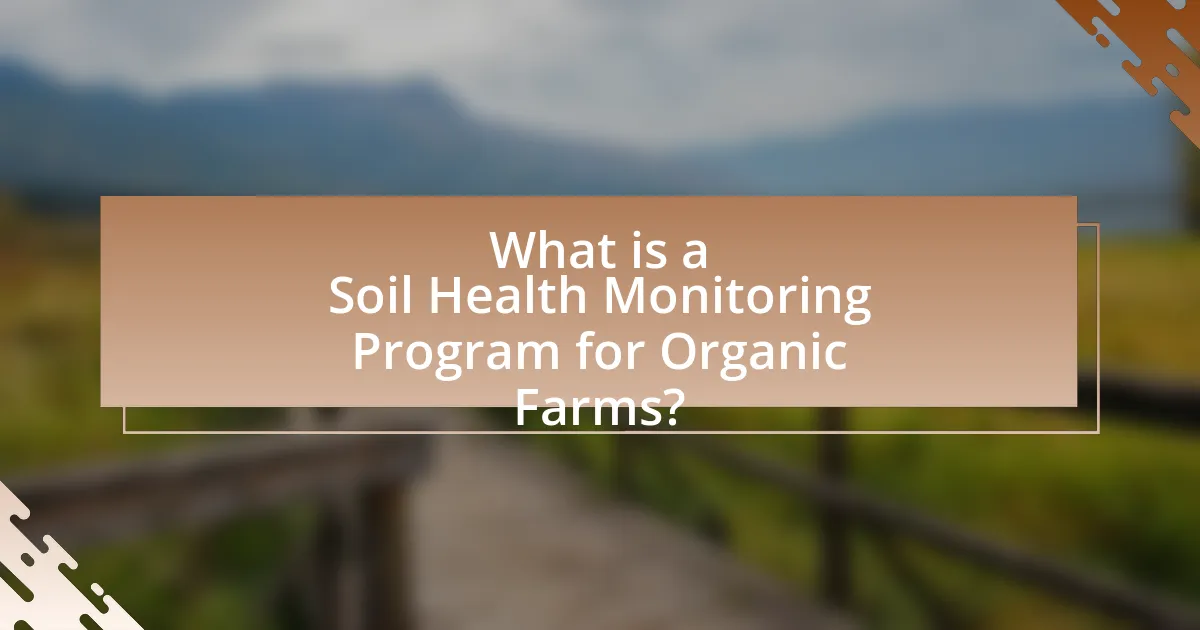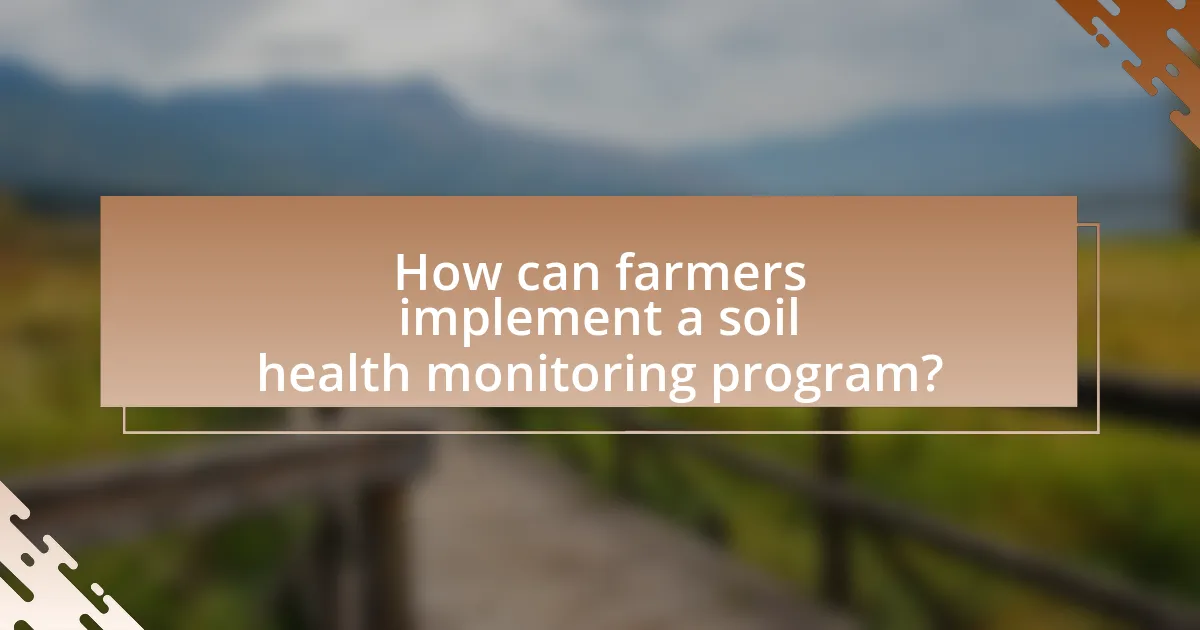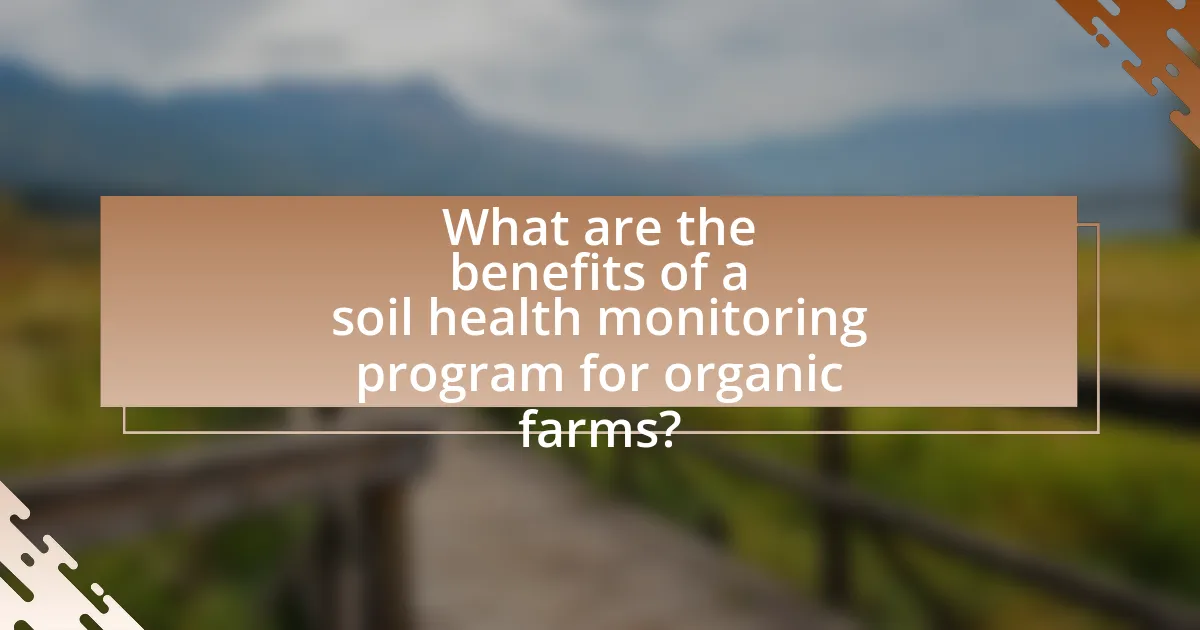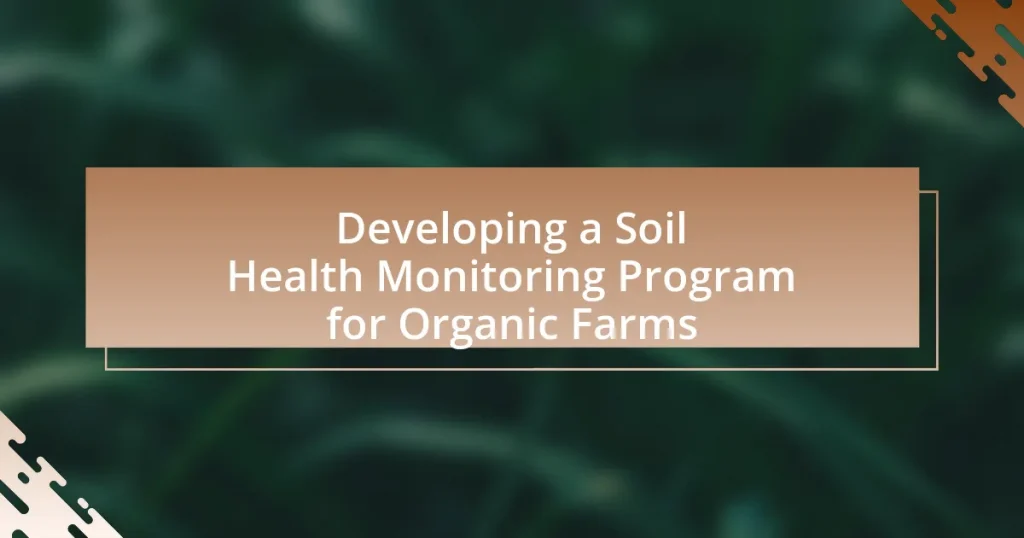A Soil Health Monitoring Program for Organic Farms is a systematic framework designed to evaluate and manage soil health by assessing its biological, chemical, and physical properties. The article outlines the importance of soil health in organic farming, highlighting key indicators such as soil organic matter, nutrient availability, and microbial activity, which directly influence crop yield and quality. It discusses the main components of a monitoring program, essential soil tests, and the frequency of assessments, while addressing challenges faced by organic farmers and strategies to overcome them. Additionally, the article emphasizes the economic and environmental benefits of implementing such programs, along with best practices and available resources for farmers to enhance soil health sustainably.

What is a Soil Health Monitoring Program for Organic Farms?
A Soil Health Monitoring Program for Organic Farms is a systematic approach to assess and manage soil health, focusing on biological, chemical, and physical properties. This program typically includes regular soil testing, monitoring of organic matter levels, nutrient availability, and microbial activity to ensure optimal conditions for crop production. Research indicates that maintaining soil health through such monitoring can enhance crop yields, improve resilience to pests and diseases, and promote sustainable farming practices. For instance, a study published in the Journal of Soil and Water Conservation highlights that farms implementing soil health monitoring saw a 20% increase in productivity over five years.
Why is soil health important for organic farming?
Soil health is crucial for organic farming because it directly influences crop productivity, nutrient availability, and ecosystem sustainability. Healthy soil fosters beneficial microbial activity, enhances nutrient cycling, and improves water retention, which are essential for organic crops that rely on natural processes rather than synthetic inputs. Research indicates that organic farming practices, such as crop rotation and cover cropping, significantly improve soil organic matter and biodiversity, leading to better soil structure and fertility. For instance, a study published in the journal “Agriculture, Ecosystems & Environment” found that organic farms had 20-30% higher soil organic carbon levels compared to conventional farms, demonstrating the positive impact of organic practices on soil health.
What are the key indicators of soil health?
Key indicators of soil health include soil organic matter, soil structure, nutrient availability, microbial activity, and pH levels. Soil organic matter is crucial as it enhances soil fertility and water retention, while soil structure affects aeration and root penetration. Nutrient availability, particularly nitrogen, phosphorus, and potassium, is essential for plant growth. Microbial activity indicates biological health, as diverse microbial communities contribute to nutrient cycling and organic matter decomposition. Lastly, pH levels influence nutrient solubility and microbial activity, with most crops thriving in a pH range of 6 to 7. These indicators collectively provide a comprehensive assessment of soil health, essential for effective soil management in organic farming.
How does soil health impact crop yield and quality?
Soil health significantly impacts crop yield and quality by influencing nutrient availability, water retention, and microbial activity. Healthy soil contains a balanced composition of organic matter, minerals, and microorganisms, which enhances nutrient cycling and improves plant growth. Research indicates that soils with high organic matter can increase crop yields by 20-30% compared to degraded soils, as they retain moisture better and provide essential nutrients more effectively. Additionally, healthy soils promote beneficial microbial communities that suppress pests and diseases, further enhancing crop quality and resilience.
What are the main components of a soil health monitoring program?
The main components of a soil health monitoring program include soil physical properties, soil chemical properties, soil biological properties, and land management practices. Soil physical properties assess texture, structure, and moisture retention, which influence water infiltration and root growth. Soil chemical properties evaluate pH, nutrient levels, and organic matter content, essential for plant health and productivity. Soil biological properties measure microbial activity and diversity, indicating soil fertility and ecosystem health. Lastly, land management practices involve crop rotation, cover cropping, and organic amendments, which enhance soil health over time. These components collectively provide a comprehensive understanding of soil conditions and guide sustainable farming practices.
What types of soil tests are essential for monitoring health?
Essential soil tests for monitoring health include pH testing, nutrient analysis, organic matter content assessment, and microbial activity evaluation. pH testing determines the acidity or alkalinity of the soil, which affects nutrient availability; optimal pH levels for most crops range from 6.0 to 7.5. Nutrient analysis identifies essential macronutrients like nitrogen, phosphorus, and potassium, as well as micronutrients, ensuring that soil fertility is maintained for healthy crop growth. Organic matter content assessment measures the amount of decomposed plant and animal material, which is crucial for soil structure, water retention, and nutrient supply. Lastly, evaluating microbial activity provides insights into soil biological health, as a diverse microbial community is vital for nutrient cycling and overall soil vitality. These tests collectively inform farmers about soil conditions and guide management practices to enhance soil health on organic farms.
How often should soil health assessments be conducted?
Soil health assessments should be conducted at least once a year. Annual assessments allow for the monitoring of changes in soil properties and the effectiveness of management practices over time. Research indicates that regular evaluations help in identifying trends and making informed decisions to enhance soil health, which is crucial for sustainable organic farming practices.
What challenges do organic farms face in soil health monitoring?
Organic farms face significant challenges in soil health monitoring, primarily due to the lack of standardized assessment methods. These farms often rely on diverse practices that vary widely, making it difficult to establish consistent metrics for soil health. Additionally, organic farms may experience limited access to advanced technology and resources for comprehensive soil analysis, which can hinder effective monitoring. Research indicates that organic farming systems often have unique soil dynamics that require tailored monitoring approaches, yet many farmers lack the training or knowledge to implement these effectively. Furthermore, the financial constraints associated with organic farming can restrict investment in necessary soil health monitoring tools and services.
How can organic farmers overcome these challenges?
Organic farmers can overcome challenges by implementing comprehensive soil health monitoring programs that utilize regular testing and data analysis. These programs enable farmers to assess soil nutrient levels, pH, and microbial activity, which are critical for maintaining soil fertility and productivity. Research indicates that consistent soil testing can lead to improved crop yields and reduced input costs, as farmers can tailor their practices based on specific soil conditions. For instance, a study published in the Journal of Soil and Water Conservation found that farms employing soil health monitoring saw a 20% increase in yield compared to those that did not. By adopting these practices, organic farmers can effectively manage soil health, enhance sustainability, and improve overall farm resilience.
What role do regulations play in soil health monitoring?
Regulations play a critical role in soil health monitoring by establishing standards and guidelines that ensure the protection and improvement of soil quality. These regulations often mandate regular assessments of soil health indicators, such as organic matter content and nutrient levels, which are essential for sustainable agricultural practices. For instance, the USDA’s National Organic Program requires organic farms to implement practices that maintain or improve soil health, thereby promoting compliance with environmental standards. This regulatory framework not only helps in monitoring soil conditions but also encourages farmers to adopt best management practices that enhance soil fertility and biodiversity.

How can farmers implement a soil health monitoring program?
Farmers can implement a soil health monitoring program by establishing a systematic approach that includes regular soil testing, data collection, and analysis. This involves taking soil samples at various depths and locations to assess key indicators such as pH, organic matter content, nutrient levels, and microbial activity. Research indicates that regular soil testing, ideally every 2-3 years, allows farmers to track changes over time and make informed decisions regarding soil management practices. Additionally, utilizing tools like soil health assessment protocols, such as the USDA’s Soil Health Assessment, can provide standardized methods for evaluating soil health. This structured approach ensures that farmers can effectively monitor and improve soil health, leading to enhanced crop productivity and sustainability.
What steps are involved in developing a soil health monitoring program?
Developing a soil health monitoring program involves several key steps: defining objectives, selecting indicators, establishing a sampling plan, conducting soil tests, analyzing data, and implementing management practices.
First, defining objectives clarifies the purpose of the monitoring program, such as improving soil fertility or assessing the impact of organic practices. Next, selecting indicators like soil organic matter, pH, and microbial activity provides measurable parameters to assess soil health. Establishing a sampling plan ensures representative soil samples are collected from various locations and depths within the farm.
Conducting soil tests involves laboratory analysis to quantify the selected indicators, while analyzing data interprets the results to identify trends and areas needing improvement. Finally, implementing management practices based on the findings helps enhance soil health over time.
These steps are supported by research indicating that systematic monitoring can lead to improved soil management and productivity in organic farming systems.
How can farmers select appropriate soil health indicators?
Farmers can select appropriate soil health indicators by assessing specific metrics that reflect soil quality and fertility. Key indicators include soil organic matter, pH levels, nutrient availability, microbial activity, and soil texture. Research indicates that soil organic matter is crucial as it enhances water retention and nutrient supply, while pH levels affect nutrient availability; for instance, a pH range of 6 to 7 is generally optimal for most crops. Additionally, measuring microbial activity can provide insights into soil biological health, as a diverse microbial community is essential for nutrient cycling. By focusing on these indicators, farmers can effectively monitor and improve soil health, leading to better crop yields and sustainable farming practices.
What tools and technologies are available for soil monitoring?
Soil monitoring tools and technologies include soil moisture sensors, pH meters, electrical conductivity meters, and remote sensing technologies. Soil moisture sensors provide real-time data on moisture levels, which is crucial for irrigation management. pH meters measure soil acidity or alkalinity, impacting nutrient availability. Electrical conductivity meters assess soil salinity, which can affect plant growth. Remote sensing technologies, such as satellite imagery and drones, allow for large-scale monitoring of soil health indicators, enabling farmers to make informed decisions about soil management practices. These tools collectively enhance the ability to monitor and manage soil health effectively in organic farming.
How can data from soil health monitoring be utilized?
Data from soil health monitoring can be utilized to enhance agricultural practices and improve crop yields. By analyzing soil nutrient levels, pH, organic matter content, and microbial activity, farmers can make informed decisions regarding fertilization, irrigation, and crop rotation. For instance, a study published in the Journal of Soil and Water Conservation found that targeted soil amendments based on monitoring data increased corn yields by 15% compared to conventional practices. This data-driven approach allows for sustainable farming, optimizing resource use while maintaining soil health over time.
What strategies can be employed to improve soil health based on monitoring data?
To improve soil health based on monitoring data, strategies include implementing cover cropping, adjusting nutrient management, and enhancing soil organic matter. Cover cropping, such as planting legumes, can increase nitrogen levels and reduce erosion, as evidenced by studies showing a 30% increase in soil organic carbon with cover crops. Adjusting nutrient management based on soil tests allows for precise application of fertilizers, reducing excess runoff and improving nutrient uptake efficiency. Additionally, enhancing soil organic matter through practices like compost application can improve soil structure and water retention, with research indicating that organic amendments can increase soil moisture retention by up to 50%. These strategies, informed by monitoring data, lead to sustainable improvements in soil health.
How can farmers communicate soil health findings to stakeholders?
Farmers can communicate soil health findings to stakeholders through detailed reports, presentations, and interactive workshops. These methods allow farmers to present data on soil health indicators, such as organic matter content and nutrient levels, in a clear and engaging manner. For instance, using visual aids like graphs and charts can effectively illustrate changes in soil health over time, making the information more accessible. Additionally, farmers can utilize digital platforms, such as social media and websites, to share findings and engage with a broader audience. Research indicates that effective communication strategies enhance stakeholder understanding and support for sustainable farming practices, thereby fostering collaboration and informed decision-making.

What are the benefits of a soil health monitoring program for organic farms?
A soil health monitoring program for organic farms enhances soil fertility, improves crop yields, and promotes sustainable farming practices. By regularly assessing soil parameters such as organic matter content, nutrient levels, and microbial activity, farmers can make informed decisions that optimize soil health. Research indicates that farms implementing soil health monitoring can experience yield increases of 10-20% due to better nutrient management and soil structure. Additionally, monitoring helps in identifying soil degradation early, allowing for timely interventions that can prevent long-term damage and support biodiversity.
How does a soil health monitoring program enhance sustainability?
A soil health monitoring program enhances sustainability by providing data-driven insights into soil conditions, which informs management practices that promote ecological balance. By regularly assessing soil health indicators such as organic matter content, nutrient levels, and microbial activity, farmers can make informed decisions that improve soil fertility and reduce reliance on chemical fertilizers. Research indicates that healthy soils can sequester carbon, thus mitigating climate change effects; for instance, a study published in the journal “Agriculture, Ecosystems & Environment” found that improved soil management practices can increase carbon storage by up to 30%. This data-driven approach not only supports sustainable agricultural practices but also contributes to long-term environmental health and resilience.
What economic advantages can be gained from improved soil health?
Improved soil health can lead to significant economic advantages, including increased crop yields and reduced input costs. Healthier soils enhance nutrient availability and water retention, which can boost agricultural productivity. For instance, a study by the USDA found that practices improving soil health can increase yields by 20% to 30% over time. Additionally, healthier soils require fewer chemical fertilizers and pesticides, leading to lower operational costs for farmers. Research published in the journal “Agronomy” indicates that investing in soil health can yield a return on investment of up to $3 for every $1 spent on soil management practices.
How does soil health monitoring contribute to environmental conservation?
Soil health monitoring significantly contributes to environmental conservation by assessing soil quality and promoting sustainable land management practices. Regular monitoring allows for the identification of soil degradation, nutrient depletion, and contamination, which can lead to informed decisions that enhance soil fertility and biodiversity. For instance, studies show that healthy soils can sequester carbon, thus mitigating climate change effects. Additionally, maintaining soil health reduces the need for chemical fertilizers and pesticides, which can harm surrounding ecosystems. Research indicates that organic farming practices, supported by soil health monitoring, can improve soil structure and function, leading to better water retention and reduced erosion, ultimately benefiting the environment.
What best practices should be followed in soil health monitoring?
Best practices in soil health monitoring include regular soil testing, which assesses nutrient levels, pH, and organic matter content. This practice enables farmers to make informed decisions regarding soil amendments and crop management. Additionally, implementing a consistent sampling strategy, such as taking samples at the same depth and time of year, ensures comparability over time. Utilizing a combination of physical, chemical, and biological indicators provides a comprehensive view of soil health. Research indicates that monitoring soil microbial activity can also reveal the soil’s biological health, which is crucial for sustainable farming practices. Regularly updating management practices based on monitoring results enhances soil fertility and crop productivity, ultimately supporting the goals of organic farming.
How can farmers ensure the accuracy of soil health assessments?
Farmers can ensure the accuracy of soil health assessments by employing standardized sampling methods and utilizing reliable laboratory analyses. Standardized sampling involves collecting soil samples from multiple locations within a field to capture variability, which is crucial for accurate assessment. According to the USDA Natural Resources Conservation Service, following specific protocols for depth, timing, and sample handling can significantly enhance the reliability of results. Additionally, using accredited laboratories that follow established testing procedures ensures that the analyses of soil properties, such as pH, organic matter, and nutrient levels, are accurate and consistent. This combination of proper sampling techniques and trustworthy laboratory services forms the foundation for precise soil health assessments.
What common mistakes should be avoided in soil health monitoring?
Common mistakes to avoid in soil health monitoring include neglecting to establish baseline data, failing to use appropriate sampling techniques, and not considering the temporal variability of soil health indicators. Establishing baseline data is crucial as it provides a reference point for future comparisons, ensuring that changes in soil health can be accurately assessed. Inappropriate sampling techniques, such as inconsistent depth or location, can lead to misleading results, as soil properties can vary significantly within short distances. Additionally, overlooking the temporal variability means that monitoring conducted at only one time may not capture seasonal changes or long-term trends, which are essential for a comprehensive understanding of soil health.
What resources are available for developing a soil health monitoring program?
Resources available for developing a soil health monitoring program include soil testing laboratories, educational materials from agricultural extension services, and guidelines from organizations such as the USDA Natural Resources Conservation Service. Soil testing laboratories provide essential data on nutrient levels, pH, and organic matter content, which are critical for assessing soil health. Educational materials from agricultural extension services offer best practices and methodologies for monitoring soil health, while guidelines from the USDA provide standardized protocols and resources for farmers to implement effective monitoring strategies. These resources collectively support the establishment of a comprehensive soil health monitoring program tailored for organic farms.
How can farmers access educational materials and support networks?
Farmers can access educational materials and support networks through agricultural extension services, online platforms, and local farming organizations. Agricultural extension services, often provided by universities or government agencies, offer workshops, publications, and one-on-one consultations to educate farmers on best practices. Online platforms, such as webinars and agricultural websites, provide a wealth of resources, including research articles and instructional videos. Local farming organizations, such as cooperatives or community-supported agriculture groups, facilitate networking opportunities and peer support, enhancing farmers’ knowledge and skills. These resources collectively empower farmers to improve their practices and connect with others in the agricultural community.
What organizations provide assistance for soil health initiatives?
Organizations that provide assistance for soil health initiatives include the USDA Natural Resources Conservation Service (NRCS), the Soil and Water Conservation Society (SWCS), and the Rodale Institute. The NRCS offers technical and financial assistance to farmers for implementing soil health practices, while SWCS focuses on promoting sustainable soil and water conservation practices through education and outreach. The Rodale Institute conducts research and provides resources on organic farming and soil health, emphasizing regenerative agriculture practices. These organizations collectively support soil health initiatives through funding, research, and educational programs.










